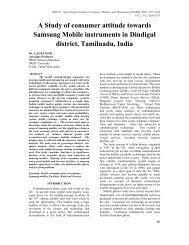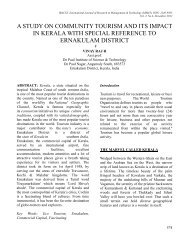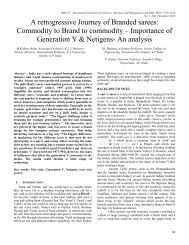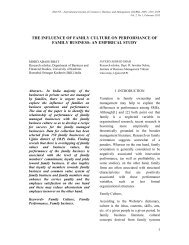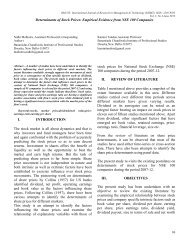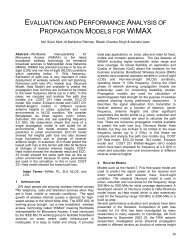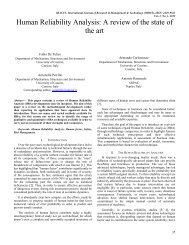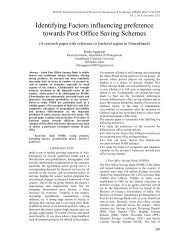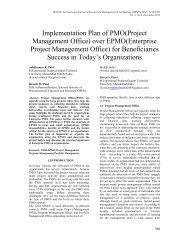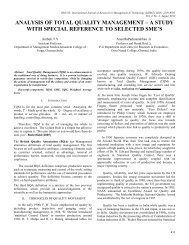The Relationship between Level of Total Quality Management (TQM ...
The Relationship between Level of Total Quality Management (TQM ...
The Relationship between Level of Total Quality Management (TQM ...
- No tags were found...
Create successful ePaper yourself
Turn your PDF publications into a flip-book with our unique Google optimized e-Paper software.
IRACST- International Journal <strong>of</strong> Research in <strong>Management</strong> & Technology (IJRMT), ISSN: 2249-9563Vol. 2, No. 3, June 2012<strong>The</strong> <strong>Relationship</strong> <strong>between</strong> <strong>Level</strong> <strong>of</strong> <strong>Total</strong> <strong>Quality</strong><strong>Management</strong> (<strong>TQM</strong>) and the <strong>Level</strong> <strong>of</strong> Culture <strong>of</strong>Teaching and Learning (COTL) in SchoolMasoumeh Pourrajab *PhD Candidate in Educational Administration, Universiti Putra Malaysia (UPM)Serdang, MalaysiaDr. Ramli BasriSenior Lecturer in Universiti Putra Malaysia (UPM)Serdang, MalaysiaDr. Shaffe Mohd DaudSenior Lecturer in Universiti Putra Malaysia (UPM)Serdang, MalaysiaDr. Soaib AsimiranSenior Lecturer in Universiti Putra Malaysia (UPM)Serdang, MalaysiaSeyedehhava MousavyMaster student in TESL, Universiti Putra Malaysia (UPM)Serdang, MalaysiaAbstract- <strong>The</strong> aim <strong>of</strong> this paper is to identify the level <strong>of</strong><strong>Total</strong> <strong>Quality</strong> <strong>Management</strong> (<strong>TQM</strong>), and the level <strong>of</strong> Culture<strong>of</strong> Teaching and Learning (COTL). Additionally, the paperaims to investigate the relationship <strong>between</strong> <strong>TQM</strong> andCOTL in Iranian secondary schools. To achieve this aims,researchers conducted a survey research and applieddescriptive method to determine the level <strong>of</strong> <strong>TQM</strong> andCOTL, as well as using correlation method to find therelationship <strong>between</strong> level <strong>of</strong> <strong>TQM</strong> and COTL. <strong>The</strong> findings<strong>of</strong> this study show that, the level <strong>of</strong> <strong>TQM</strong> and COTL is highin Iranian secondary schools. It also finds that an increase inthe level <strong>of</strong> <strong>TQM</strong> in schools will also increase the level <strong>of</strong>COTL.Keywords- <strong>Total</strong> quality management, culture <strong>of</strong> teachingand learning, Iranian secondary schoolI. INTRODUCTIONAfter World War II Edward Deming developed <strong>TQM</strong>which is a widespread management idea to maintain andimprove the quality <strong>of</strong> goods and it was first embraced bythe Japanese industrial sector [1]. <strong>The</strong> theoretical basis <strong>of</strong><strong>TQM</strong> came from several scholars notably; W. EdwardsDeming, Joseph M. Juran and Philip Crosby in the Americaand Genichi Taguchi and Kaoru Ishikawa in Japan [2, 3].Americans did not take <strong>TQM</strong> seriously until 1950 when theJapanese accepted it to restore their business and industryactivities after the war. <strong>The</strong> world markets were dominatedby Japanese till 1980’s because they took <strong>TQM</strong> seriously.Meanwhile, the U.S. companies had ultimately accepted toupdate and change their model <strong>of</strong> assembly line into theglobal competitive economic markets since it belong to thenineteenth century and was really out <strong>of</strong> date [4].Nowadays it is very necessary to improve and enhancethe quality in some areas such as industry, manufacturing,health, and education [5]. All organizations in spite <strong>of</strong> theirstructure, culture, and goals such as business company;319
corporations, service organizations, universities, and schoolscan apply <strong>TQM</strong> principles [6]. Deming [7] pointed out those<strong>TQM</strong> principles that are utilized in industry can be used ineducational institutions and the process <strong>of</strong> education toimprove outcome and performance. <strong>The</strong> purpose <strong>of</strong> theeducation system and schools is to increase the number <strong>of</strong>students who can fulfill or go beyond the pr<strong>of</strong>iciency levels<strong>of</strong> academic achievement and prove themselves highlyskillful and competitive in high technology in the modernworld [8]. This needs a change in the schools and educationsystem and to bring about this change they should focus onstudents need to be successful in today’s and future world[9]. So schools must improve the structure and culture <strong>of</strong> theschool itself [10].To achieve these goals, school must improve the Culture<strong>of</strong> Teaching and Learning (COTL) as a first step and thenapply some quality improvement model like <strong>Total</strong> <strong>Quality</strong><strong>Management</strong> (<strong>TQM</strong>). In this way efficiency andeffectiveness <strong>of</strong> the school can be enhanced [11]. In thisresearch COTL refers to the values, norms, behaviors,climate and attitudes <strong>of</strong> teachers, principals, and studentstowards teaching and learning. <strong>The</strong> most important conceptin COTL is culture. Culture change within an organization iscreated by a number <strong>of</strong> factors, including behaviors basedon people interactions, norms, resulting from teams andindividuals, dominants values by the organization and theclimate <strong>of</strong> the organization [12]. In the context <strong>of</strong> education,culture refers to behavior based on educators (teachers andprincipals) and students interaction, norms and criteriaresulting from team work, individuals’ dominant values,educators and learners attitudes towards teaching andlearning and provisions <strong>of</strong> services. <strong>The</strong>se attitudes involvethe spirit <strong>of</strong> devotion and commitment in and to a school’sculture, which develops through the combined efforts <strong>of</strong>school management and leadership.<strong>TQM</strong> has attracted the interest <strong>of</strong> many theorists andpractitioners such as DeCosmo, Parker and Heverly [13],Ewell [14], Sherr and Lozier [15], Bonser [16], Tribus [17],Brigham [18], and Rhodes [19], and later they worked onapplicability <strong>of</strong> <strong>TQM</strong> theories in the educational area.<strong>The</strong>se scholars also explained that educational institutionshave applied <strong>TQM</strong> for a lot <strong>of</strong> reasons that industries andbusinesses have instituted quality programs. According tothis Cunningham [11] suggested that <strong>TQM</strong> models must beredesigned in order to fit the educational goals in schools.Walpole and Noeth [20], pointed out that applying <strong>TQM</strong> ineducation system can improve the performance <strong>of</strong> schoolsespecially improving teaching and learning quality. Toachieve these goals, researchers search the notion <strong>of</strong> <strong>TQM</strong>in terms <strong>of</strong> its philosophy, principles, culture andimplementation <strong>of</strong> <strong>TQM</strong> in school. Some scholars such asKumar, Choisne, Grosbois and Uma Kumar [21] pointed outthat the principles <strong>of</strong> <strong>TQM</strong> could be used as a means forboosting students’ morale, raising productivity, saving time,empowering people at all levels, enhancing moral <strong>of</strong>educators, and providing higher quality services toIRACST- International Journal <strong>of</strong> Research in <strong>Management</strong> & Technology (IJRMT), ISSN: 2249-9563Vol. 2, No. 3, June 2012customers. In other words, by applying <strong>TQM</strong> principles,improvement in quality helps to diminish waste and raiseproductivity hence keeping costs low and raising studentsatisfaction. Also, the COTL will be increased by applying<strong>TQM</strong> in education.320Iranian education system like other education systemswas also looking for methods and strategies to improve itsquality and to keep up with the world standards [22].Despite great efforts to change the school-oriented system tostudent-oriented one as a general goal, the schoolperformance particularly the quality <strong>of</strong> COTL, could notimprove as expected [23]. Now the top executives in theeducation system <strong>of</strong> Iran believe in changing the presentstructure and, improving COTL is the key for improvingschool performance [24]. So educators are looking for asolution to solve the mentioned educational problems [11]and a model or models to improve the school structure orculture so as to improve the quality <strong>of</strong> education in Iran.Kamali [25] in his studies presented that some <strong>of</strong> the <strong>TQM</strong>principles have been applied in the education system <strong>of</strong> Iranlike new teaching techniques, emphasis on pre-serviceteacher training, in-service training for teachers andprincipals, upgrading classes with the world facilities,improving evaluation methods, employing team and groupwork in class, paying attention to teachers knowledge andmotivation, and organizing parents association. But theinfluence <strong>of</strong> all these points (improvements) has not beenexplicitly specified, the present researcher could find verylittle literature focusing on the application <strong>of</strong> this model indifferent databases such as Pro-Quest, and Emerald,especially in the province <strong>of</strong> Lorestan (researchpopulation), Iran. <strong>The</strong>refore, this area is still in needs <strong>of</strong>further research. Hence, the present study tries to identifylevel <strong>of</strong> <strong>TQM</strong> and <strong>Level</strong> <strong>of</strong> COTL implementation inschools, and investigate the relationship <strong>between</strong> these twovariables. To achieve this goal, one general hypothesis andtwo detailed hypotheses were stated as follows:General Hypothesis: there is a statistically significantrelationship <strong>between</strong> the level <strong>of</strong> <strong>TQM</strong> and the level <strong>of</strong>COTL in school.Hypothesis one: there is a statistically significantrelationship <strong>between</strong> the level <strong>of</strong> <strong>TQM</strong> and the level <strong>of</strong>COTL based on principals’ view in school.Hypothesis two: there is a statistically significantrelationship <strong>between</strong> the level <strong>of</strong> <strong>TQM</strong> and the level <strong>of</strong>COTL based on teachers’ view in school.
IRACST- International Journal <strong>of</strong> Research in <strong>Management</strong> & Technology (IJRMT), ISSN: 2249-9563Vol. 2, No. 3, June 2012METHODOLOGYTable 1: Distribution <strong>of</strong> years <strong>of</strong> experienceII.This research was carried out in secondary schoolslocated Lorestan Provinces <strong>of</strong> Iran. <strong>The</strong> target population <strong>of</strong>this study was principals and teachers <strong>of</strong> public schools,which included 1354 teachers and 206 principals. <strong>The</strong>sample comprised <strong>of</strong> 280 teachers and 40 principals. <strong>The</strong>respondents <strong>of</strong> the study were selected using random andcluster sampling method. First, all secondary schools weredivided into two geographical regions (east, and west) andtwo cities were selected randomly in each region (four citiesas whole). For each city 20 schools were selected randomly.For each school seven teachers were selected randomly andevery principal <strong>of</strong> these schools are selected as respondents.So in total the respondents include 280 teachers and 40principals.PrincipalTeacherN % Mean SD N % Mean SD≤10 1 2.5 19.73 3.85 62 22.1 16.29 6.31years11-20 28 70 152 54.3years21-30 11 27.5 60 23.6years<strong>Total</strong> 40 100280 100<strong>The</strong> results in Table 1, shows that the majority <strong>of</strong>principals and teachers in this study has working experience<strong>between</strong> 11-20 years.<strong>The</strong> research instrument was a set questionnaireprepared by Rampa [26] for data collection in his research.<strong>The</strong> questionnaire was divided into three sections; Socio-Demographic data, COTL, and <strong>TQM</strong>. This questionnaireconsists <strong>of</strong> 30 items which were completed by teachers andprincipals. <strong>The</strong>y were asked to complete the descriptiveitems as much as they are true for their schools based on theLikert Scale. This scale involved a minimum score <strong>of</strong> 30and a maximum score <strong>of</strong> 120 and a subsidiary dimensionwith a range <strong>of</strong> 1 to 4. SPSS s<strong>of</strong>tware was used to determinethe reliability <strong>of</strong> the questionnaire. <strong>The</strong> Cronbach’s alphavalue was 0.86 and this showed that the questionnaire has aquite satisfactory reliability [27].<strong>The</strong> researchers used descriptive method to determinethe level <strong>of</strong> <strong>TQM</strong> and level <strong>of</strong> COTL, and applied PearsonCorrelation method to investigate the relationship <strong>between</strong>level and <strong>TQM</strong> and level <strong>of</strong> COTLIII. RESULTS AND DISCUSSION<strong>The</strong> collected data shows that out <strong>of</strong> 320 participants in thisstudy, 280 respondents (87.5%) were teachers, and 40respondents (21.5%) were principals. <strong>The</strong> majority <strong>of</strong>respondents, i.e. 168 (52.5%) were female and 152 (47.5%)were male. This study considers the experiences <strong>of</strong>educators from 1 year to 30 years. <strong>The</strong> data shows only oneprincipal (2.5%) had less than 10 years <strong>of</strong> experience, 28principals (70%) <strong>between</strong> 11-20 years experience, and 11principals (27.5%) more than 21 years <strong>of</strong> experience(M=19.73; SD=3.85). Another hand, 62 teachers (22.1%)had less than 10 years <strong>of</strong> experience, 152 teachers (54.3%)<strong>between</strong> 11-20 years experience, and 60 teachers (23.6%)more than 21 years <strong>of</strong> experience (M=16.29; SD=6.31).Additionally, based on the distribution <strong>of</strong> their degrees,only one principal (2.5%) had diploma and one principal(2.5%) had associate diploma degree, 38 principals (95%)had bachelor degree, as well as 93 teachers (33.2%) hadassociate diploma, 174 teachers (62.1%) had bachelordegree and 13 teachers (4.6%) had master degree.Table 2: Distribution <strong>of</strong> qualificationPrincipal TeacherN % N %Diploma 1 2.5 0 0Associate 1 2.5 93 33.2diplomaBachelor 38 95 174 62.1Master 0 0 13 4.6<strong>Total</strong> 40 100 280 100As can be seen from Table 2, the majority <strong>of</strong> educatorsparticipated in this study had bachelor degree.Table 3 shows that the level <strong>of</strong> <strong>TQM</strong>. As can be seen thelevel <strong>of</strong> <strong>TQM</strong> is high based on principals and teachers view.Table 3: Mean distribution <strong>of</strong> <strong>TQM</strong> levelMean SD <strong>Level</strong>Principal 3.12 0.65 HighTeacher 3.08 0.72 HighNote: Low (1.00
IRACST- International Journal <strong>of</strong> Research in <strong>Management</strong> & Technology (IJRMT), ISSN: 2249-9563Vol. 2, No. 3, June 2012Table 4: Mean distribution <strong>of</strong> COTL levelTable 6: Results <strong>of</strong> Pearson Correlation based onteachers viewMean SD <strong>Level</strong><strong>TQM</strong> COTLPrincipal 3.03 0.71 HighPearson Correlation 1 0.47**Sig. (2-tailed) 0.00Teacher 3.05 0.77 HighN 280 280Note: low (1.00
IRACST- International Journal <strong>of</strong> Research in <strong>Management</strong> & Technology (IJRMT), ISSN: 2249-9563Vol. 2, No. 3, June 2012REFERENCES19. Rhodes, L.A., On the road to quality. EducationalLeadership, 1992. 49(6): p. 76-80.20. Walpole, M. and R.J. Noeth, <strong>The</strong> promise <strong>of</strong>1. Svensson, M. and B. Klefsjo, <strong>TQM</strong>-based SelfassessmentBaldrige for K–12 education, in ACT Office <strong>of</strong>in the Education Sector, ExperiencesPolicy Research. 2002, New Jersey and Asburyfrom a Swedish Upper Secondary School Project.Park High School (NJ).<strong>Quality</strong> Assurance in Education, 2006. 14(4): p. 21. Kumar, et al., Impact <strong>of</strong> <strong>TQM</strong> on Company's299-323.Performance. International Journal <strong>of</strong> <strong>Quality</strong> &2. Beckford, J., <strong>Quality</strong>: A Critical Introduction. 3rdReliability <strong>Management</strong>, 2009. 26(1): p. 22-37.ed. 2009, London: Routledge.22. Ministry <strong>of</strong> Education <strong>of</strong> the I.R. the Iran, National3. Speegle, M., <strong>Quality</strong> Concepts for the ProcessReport on Development <strong>of</strong> Education in the I.R. <strong>of</strong>Industry. 2nd ed. 2010, New York: Delmar Pub.Iran with an Emphasis on Inclusive Education a4. Dheeraj, M., Applying <strong>Total</strong> <strong>Quality</strong> <strong>Management</strong>way to Future. 2008, Devised by, Bureau <strong>of</strong>in Academics, <strong>Quality</strong> Guide to the Non-formal andInternational Scientific Cooperation.Informal learning Processes. 2004, SEEQUEL.23. Mirderikvand, A., Preparing for Implementation <strong>of</strong>5. Singh, V., S. Grover, and A. Kumar, Evaluation <strong>of</strong><strong>TQM</strong> in Headquarter in Lorestan Province, in<strong>Quality</strong> in an Educational Institute: a <strong>Quality</strong>Education. 2007, Azad University: Tehran.Function Deployment Approach. Educational 24. Chisholm, L. and S. Vally, <strong>The</strong> culture <strong>of</strong> learningResearch and Reviews, 2008. 3(5): p. 156-162.and teaching in Gauteng schools: report <strong>of</strong> the6. Ngware, M.W., D.K. Wamukuru, and S.O.Committee on the culture <strong>of</strong> learning and teaching.Odebero, <strong>Total</strong> <strong>Quality</strong> <strong>Management</strong> in Secondary1996: Education Policy Unit, University <strong>of</strong> theSchools in Kenya: extent <strong>of</strong> practice. <strong>Quality</strong>Witwatersrand.Assurance in Education, 2006. 14(4): p. 339-362. 25. Kamali, A., What Is the Main Problem Facing to7. Deming, E., Out <strong>of</strong> the Crisis: <strong>Quality</strong>, ProductivityPublic Education System in Your Community?and Competitive Position. 1986, Cambridge:Quarterly Journal <strong>of</strong> Education, 2009. 25(3).Cambridge University Press.26. Rampa, S.H., <strong>The</strong> <strong>Relationship</strong> <strong>between</strong> <strong>Total</strong>8. Burke, W.W., Organization change: <strong>The</strong>ory and<strong>Quality</strong> <strong>Management</strong> and School Improvement.practice. 3rd ed. 2010: Sage Publications, Inc.2004, University <strong>of</strong> Pretoria: South Africa.9. Comer, J.P. and H.L. Gates, Leave no child behind: 27. Ary, D., L.C. Jacobs, and A. Razavieh,Preparing today's youth for tomorrow's world.Introduction to Research in Education. 8th ed.2004: Yale Univ Pr.2009, California: Wadsworth Publishing Co.10. Burke, W.W., D.G. Lake, and J.W. Paine, 28. Lodico, M.G., D.T. Spaulding, and K.H. Voegtle,Organization Change: A Comprehensive Reader.Methods in Educational Research: from <strong>The</strong>ory to2009, Sun Francisco: Jossey-Bass.Practice. 2006, San Francisco: Wiley.11. Cunningham, M.K., Educator Attitudes towards the 29. Heyward, R.P. and G.M. Steyn, <strong>The</strong> potential <strong>of</strong>Appropriateness <strong>of</strong> <strong>Total</strong> <strong>Quality</strong> <strong>Management</strong>: Atotal quality education: a case study <strong>of</strong> a primarySurvey <strong>of</strong> Elementary and middle Schoolschool in South Africa. South Africa Journal <strong>of</strong>Administrators and Faculty. 2007, CapellaEducation, 2001. 21(2).University.30. Grahamstowm. St andrew’s Preparatory School in12. Oakland, J., <strong>Total</strong> <strong>Quality</strong> <strong>Management</strong>: Text withGrahamstowm. 2011; Available from:Cases. 2003, London: Butterworth-Heinemann.http://www.grahamstown.co.za.13. DeCosmo, R.D., J.S. Parker, and M.A. Heverly,<strong>Total</strong> quality management goes to communitycollege. New Directions for Institutional Research,1991. 1991(71): p. 13-25.14. Ewell, P.T., <strong>Total</strong> quality and academic practice:the idea we've been waiting for? Change, 1993.25(3): p. 49-55.15. Sherr, L.A. and G. Gregory Lozier, <strong>Total</strong> qualitymanagement in higher education. New Directionsfor Institutional Research, 1991. 1991(71): p. 3-11.16. Bonser, C.F., <strong>Total</strong> <strong>Quality</strong> Education? PublicAdministration Review, 1992. 52(5): p. 504-512.17. Tribus, M., <strong>TQM</strong> in Education: <strong>The</strong> <strong>The</strong>ory andHow To Put It To Work. 1993.18. Brigham, S.E., <strong>TQM</strong>: Lessons we can learn fromindustry. Change, 1993. 25(3): p. 42-48.323



